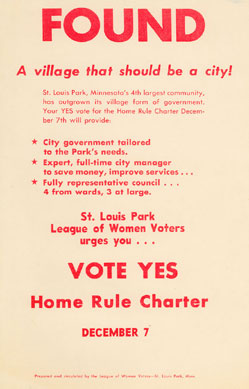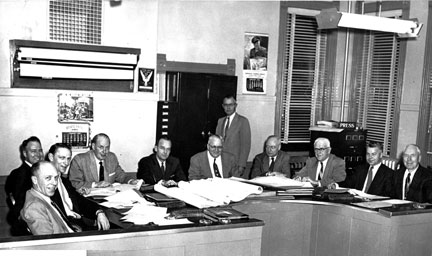In the 1930s St. Louis Park was still a Village with only a part-time Village council, and it found itself ill-equipped to address the issues of zoning, planning, infrastructure, and public facilities necessary for a booming residential community. Home rule would allow Park to become a full-fledged city and hire a city manager to handle administrative affairs.
The St. Louis Park Better Government League (BGL) was organized in 1935, with Morton Arneson serving as Chairman. Arneson was particularly incensed about the Village’s poor law enforcement, particularly when it came to the bars on Excelsior Blvd., where he lived. The BGL met monthly at the home of local attorney Milo Clark. The group set about promoting a reform candidate for Mayor, and succeeded in getting Roy O. Sewell elected, despite harassment and threats. Although the BGL was unable to find a candidate for Mayor in the next election, they did succeed in helping to elect Torval Jorvig and Joe Justad to the Council, two men who tried to keep the liquor licenses at bay.
The Civic and Commerce Association of St. Louis Park was also formed in 1935, perhaps as another response to a corrupt local government. Edwin H. Renner was President of the newly-formed group, and the other officers were H.J. Bolmgren, E.H. Shursen, and J.E. Pockrandt. In a letter dated October 16, 1935, Renner indicated that the group strove to be:
a medium through which meritorious civic projects may be initiated and constructive ideas be given the benefit of a public hearing and discussion. Our citizens need us as a vehicle through which they may move to accomplish the things to be done in providing the best in planning, transportation, utilities, schools, form of government and opportunities for livelihood.
FIRST ELECTION
In June 1938, a group led by Morton Arneson petitioned the Hennepin County District court to appoint a Charter Commission. The Commission drafted the first version of the City Charter, which called for a council-manager type government. The city of Albert Lea had a model council-manager structure, and Arneson brought a busload of Park officials to that city to see how efficiently it was run. Arneson was convinced that it was the way to go and that he would be treated more fairly under a similar system.
An election was held on September 10, 1940, but the charter was rejected by the electorate by a vote of 1,340 to 937. This represented a percentage of 41.2, whereas the required percentage was 57.14 or 4/7ths majority. Only the district made up of the North Side gave the charter the required majority.
SECOND ELECTION
A second Charter Committee was appointed by the Hennepin County District Court in 1947, with Morton Arneson and Leland F. Leland the only holdovers from the first commission.
A group called the Charter Fact Finding Committee, led by C.L. Hurd, published its opposition in a full page ad in the Dispatch on March 25, 1949, citing the fact that the charter had no tax limit, would give the city manager too much power, and that a new Village code authorized by the State was adequate. Hurd and the business community also opposed it because businessmen were not given “their rightful spot in the formation of a charter.” It was also thought that some Village employees opposed it because it would cost them their jobs.
In addition, the night before the election, an anonymous pamphlet was distributed to every home in the Park, personally attacking Arneson as “Little Joe Stalin – Wants Complete Control.” The charge was that Arneson would appoint the City Manager and thus control the City, since he was already the Chairman of the Better Government League, Charter Commission, and the Planning Commission. Arneson suspected that it was C.L. Hurd who put out this pamphlet.
The second Home Rule Charter election was held on March 29, 1949. Only 39 percent of the electorate voted but the turnout was still deemed to be surprisingly large. The charter was rejected by a vote of 2,050 to 1,345. To pass it needed a 4/7ths majority – 57.14 percent – and only got 39.9 percent.
After this charter was rejected, the Better Government League immediately worked to get a third Charter Commission appointed by the court.
THIRD ELECTION
 A new Charter Commission was proposed by Hurd on January 21, 1952. Morton Arneson moved to Edina in 1953, and Attorney Everett Drake became Chairman of the 14-member Charter Commission. Drake drafted a strong document, and it was endorsed and advocated by the newly-formed League of Women Voters, a “powerful and respected organization in the community” according to the Dispatch. The charter was also endorsed by Caroll Hurd, who, with Kenneth W. Wolfe, placed an endorsement in the Dispatch as co-chairmen of the Charter Adoption Committee. Members of the Charter Commission were:
A new Charter Commission was proposed by Hurd on January 21, 1952. Morton Arneson moved to Edina in 1953, and Attorney Everett Drake became Chairman of the 14-member Charter Commission. Drake drafted a strong document, and it was endorsed and advocated by the newly-formed League of Women Voters, a “powerful and respected organization in the community” according to the Dispatch. The charter was also endorsed by Caroll Hurd, who, with Kenneth W. Wolfe, placed an endorsement in the Dispatch as co-chairmen of the Charter Adoption Committee. Members of the Charter Commission were:
Maurice Adelsheim, Jr.
William R. Chapman
James S. Cullen
Everett Drake
Tres F. Goetting
Mrs. Gertrude Hognander,
Fred W. Kaeppel
J.E. Adolph Karlsson
Lelan F. Leland
Lydia Rogers,
Edmund T. Montgomery
Catherine Westerdahl
Edward Rouse
Walter Wheeler
On December 7, 1954, St. Louis Park’s Home Rule Charter was approved by the electorate by a vote of 2,822 to 734. 23 percent of the electorate voted. Herb Davis (Trustee), Joe Justad (City Clerk), Russell Connery (Assessor), and Anton Yngve (Justice of the Peace) were elected at this time. Russell Fernstrom had been elected Mayor on December 9, 1953, and remained in office during the transition. On December 10, the Council canvassed the votes and declared the charter adopted and new members elected. The newly-elected Council members took office on January 3, 1955.
The new charter took effect on January 7, 1955 – 30 days after the election per state law – and St. Louis Park was officially designated a City. On January 10, Phil Smith, City Engineer, was appointed (interim) City Manager. At the January 17 City Council meeting, C.L. Hurd and Howard Perkins were appointed to fill the two additional council seats created by the Charter. The first City Manager was Tom Chenoweth. See Mayors and City Managers.
A City election was held on December 6, 1955, and the following people were elected:
Russell C. Fernstrom – Mayor
Herb Davis and Torval Jorvig – Councilmen at Large
Bob Ehrenberg – Councilman, Ward I
H.J. Bolmgren – Councilman, Ward II
Gene Schadow – Councilman, Ward III
Ken Wolfe – Councilman, Ward IV
E.A. Linnee – Justice of the Peace
The newly-elected officers took office on January 9, 1956. Fernstrom would remain Mayor until 1959.

With the adoption of the Charter (and the move of Arneson), the Better Government League, which had started in 1935 to quiet down the beer joints on Excelsior Blvd., disbanded.
For another perspective on the development of the Charter, see Bob Reiss’s story about Herb Davis from the Re-Echo.
